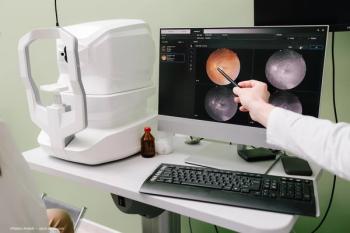
Gold micro-shunt shows promise for lowering IOP
New York-A gold micro-shunt (GMS, SOLX) implant holds promise for reducing complications of trabeculectomy by lowering IOP, said Celso Tello, MD.
Dr. Tello, assistant professor of ophthalmology at New York Medical College, is participating in an American trial of the device, which is made of 24-carat gold. The device is not yet available clinically in the United States but was approved for use in Europe last October.
At present there are two models of the GMS. Both are 6 mm long, 2 mm wide. One is 60 μm thick, the other 40 μm thick. They are the smallest devices available for lowering IOP, Dr. Tello noted at the Glaucoma 2006 meeting here. Each device is intended for subscleral implantation through a single small incision. The implantation can be done in about 15 minutes.
"Connecting the anterior chamber with the suprachoroidal space dramatically reduces IOP," Dr. Tello said. "This can be explained by a suctioning effect of the suprachoroidal space on adjacent tissues."
Dr. Tello described the results of a European trial of 67 patients with an average preoperative IOP of 28 mm Hg. Pressure dropped 40% or more at 24 months postoperatively.
Complications were minor, he said. Four patients developed hyphema, which resolved within 3 days. There were two cases of corneal edema, localized to the implant position. Two IOP spikes were reported; one was resolved by laser treatment. There was one case of choroidal effusion, followed by retinal detachment. One device was misplaced in the sclera, so that it reached the subconjunctival space. It was removed and a new device was implanted properly.
"Connecting the anterior chamber and the supraciliary space with a biocompatible gold micro-shunt is an ideal concept for internal drainage of the aqueous humor to lower the IOP in patients with glaucoma," Dr. Tello said. "The initial results of the European trials are promising and we are hoping that by next year we'll be discussing the results of the current U.S. trials."
The GMS is a component of the DeepLight Glaucoma Treatment System, which includes a long-wavelength, deep-penetrating titanium sapphire laser.
Newsletter
Don’t miss out—get Ophthalmology Times updates on the latest clinical advancements and expert interviews, straight to your inbox.













































